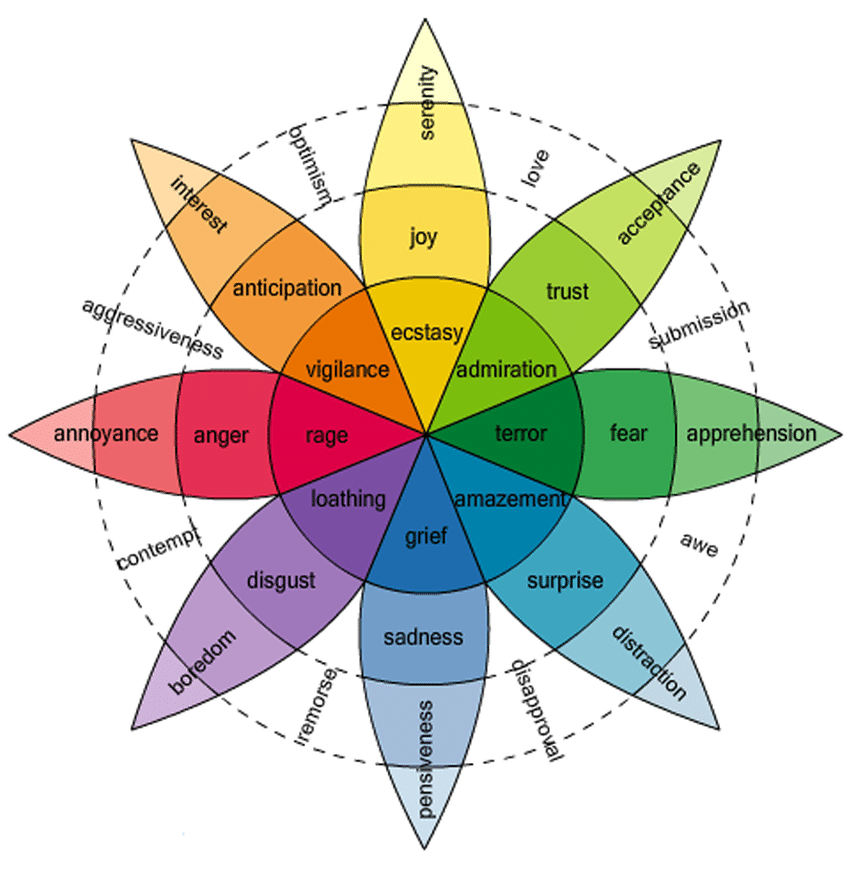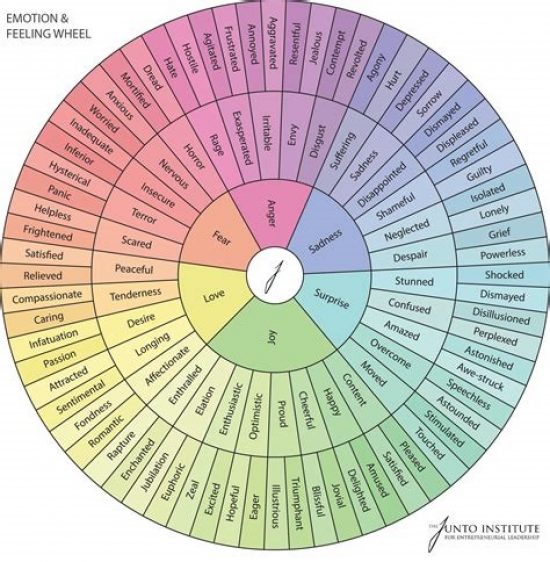An emotion wheel is a great visual aid to help us identify how we’re feeling, and also to expand our emotional vocabulary. Being able to identify emotions is a key building block of emotional intelligence.
According to PositivePsychology.com, there are around 34,000 human emotions (I’ve collected about a thousand of them in this post). How many of them could you name? The more rich and comprehensive our emotional vocabulary, the better we can connect with, understand, and communicate our emotional experience.
Why? Because the words we know literally shape our experience of the world. Imagine travelling back in time 500 years, and showing someone a mobile phone. How would they describe it to someone else? How would they put into words the concepts of electronics, telecommunications, apps, WiFi, internet, infotainment…? Heck, according to OECD information, only 12% of the population could read and write in 1820 (source), so going back 500 years, there would be very few people who could even start to make sense of anything written, let alone a device that lets you communicate with friends or strangers on the other side of the world.
So, the broader our vocabulary, the more nuanced and comprehensive our experience of the world will be. You can use these emotion wheels to expand your vocabulary, and really tune in to the emotions you are experiencing.
What is emotional intelligence?
Emotional intelligence (EQ) is the ability to recognise our own, and other people’s emotions, and to respond effectively.
According to Salovey and Mayer, there are five aspects to emotional intelligence:
- Knowing one’s emotions
- Managing emotions
- Motivating oneself
- Recognising emotions in others
- Handling relationships
One of the greatest things about EQ is that it is a set of skills that most people can cultivate and develop. It’s never too late to start, and using an emotion wheel can be a great help. I’ll be writing more about EQ in the future, so keep an eye out on this website, or sign up to my monthly newsletter to be notified of new articles.
A few quick notes on emotions
The world we live in isn’t always friendly to emotions – in fact, at times, it’s downright hostile to them. Just think about how often “emotional” is thrown around as an insult. Rather than being our enemy, emotions actually provide us with data about what is happening around and within us.
Developing emotional awareness
Many people worry that if they start thinking and talking about emotions and feelings, they’ll get “stuck” in them. But the reverse is actually true: when we can connect with what we’re feeling and acknowledge the emotions that are present, they tend to move on relatively quickly, and we’re unlikely to be completely overwhelmed.
For example, we sometimes hold back tears because we feel like if we let ourselves cry, we’ll never stop – but it is physiologically impossible to cry forever! In fact, most people find they stop naturally after a few minutes, and 90-95% of crying bouts last for no more than 15 minutes.
Why numbing our emotions doesn't help
On the other hand, trying to stuff our emotions down can cause far more problems. As Brené Brown points out, there’s no such thing as selective numbing of our emotions – if we squash our anger, we also squash our capacity to feel joy.
This isn't an excuse...
Now, this isn’t to say we should give free reign to everything we’re feeling – there’s definitely a time and a place for things! And sometimes, we just have to get on with something in spite of how we’re feeling.
But we’re unlikely to do ourselves or others any harm by developing a practice of being aware of our emotions.
Dealing with strong emotions
In future posts, I’ll talk more comprehensively about how we can respond to emotions in ourselves and others.
In the meantime, if you notice a strong emotion coming up that’s making you feel uncomfortable, try some “resonant breathing”. For 5 to 10 breaths, focus on making your in- and out-breaths the same length. Try not to “force” your breathing, but rather gently bring your awareness to it, and see if you can breathe into your belly, and slowly exhale through your nose, or pursed lips (like you’re whistling).
The original emotion wheel, thanks to Plutchik
Plutchik identified eight basic emotions, and believed that these, individually and in combination, and varying in intensity over time and context, made up the human emotional experience (he also studied animals). He theorised that the emotions we feel drive our behaviours and actions.
The Plutchik emotion wheel consists of four sets of paired opposites:
- Joy and sadness
Human response: connect or withdraw - Fear and anger
Human response: shrink and hide or get big and loud - Anticipation and surprise
Human response: examine closely or jump backwards - Disgust and trust
Human response: reject or embrace

Other emotional wheel examples
Most emotion wheel examples found elsewhere around the internet stem directly or indirectly from Plutchik’s work, although they sometimes reverse the order (i.e. more intense emotions are around the outside of the emotion wheel, with the less-intense emotions in the centre).
Junto Institute emotion wheel
The Junto Institute emotion wheel differs from Plutchik’s by having only six basic emotions represented in the centre, and branching outwards to more complex emotions at the outer edge.

Morrison Clinic emotion wheel
The Morrison Clinic emotion wheel has fewer options at the outer edge than the Junto Institute’s, so it might be an easier one to start identifying emotions with.

How to use an emotion wheel
An emotion wheel can be a great way to train yourself to think more carefully and deeply about the emotions you are experiencing.
The easiest way to use an emotion wheel is to print it out and keep it beside you during the day. It doesn’t really matter which wheel you choose – they’re all helpful.
Grab it when you’re about to take a break, or when you notice you’re feeling something. Have a look at the wheel and see if you can find one or more words that fit how you’re feeling at that exact moment. It’s totally normal to experience several emotions at the same time.
You can also use the wheel to think about a situation in the past. Can you remember a time when it felt like you over-reacted to something? Or someone over-reacted with you? Hunt around the wheel to find the emotion(s) that you and the other person might have been experiencing at the time.
Why is this useful?
The better you become at identifying your own (and other people’s) emotions, the greater the likelihood that you’ll be able to navigate challenging situations.
For example, imagine you’re feeling ecstatic because you just got a promotion you’ve been dreaming about. You tell a friend your great news, and their reaction is really flat – they don’t smile or respond positively, which is unexpected. If you aren’t skilled at sensing emotions, you might make up a story about why they aren’t congratulating you excitedly. But if you have cultivated your ability to detect emotions, you might notice that they seem sorrowful. Once you’ve identified this, then you can respond to them with compassion, instead of annoyance.
This ability can also help you anticipate challenging situations and decide how you will respond. For example, if you have to give someone some bad news, you can think about how you, and they, might feel, and what you can do to make the conversation flow more smoothly.
Long story short: being able to identify and anticipate emotions can make life easier for yourself and others!
Have you found a different emotion wheel?
I’m always on the lookout for great resources. Have you come across an emotion wheel that you found helpful? Share with me in the comments, or drop me an email.



2 thoughts on “How to use an emotion wheel to build your emotional intelligence”
Pingback: Why you need rest to be your best ~2021 ~ Daria Williamson
Pingback: How To Choose Your Approach This Silly Season ~2021 ~ Daria Williamson - Coach, Trainer, Facilitator
Comments are closed.